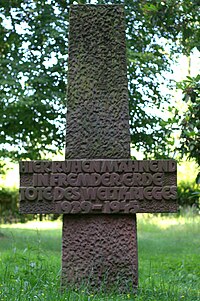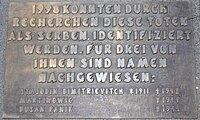Main camp IX A
The main camp IX A ("Stalag IX A") in Trutzhain near Ziegenhain was a prisoner of war camp in Northern Hesse that existed during the Second World War and was used in another function after the end of the war.
A large number of the historical barracks have been preserved, and the basic structure of the camp still exists today in the old town center of Trutzhain ; it has been a listed building since 1985. Today a memorial commemorates the history of the place.
Setup and use
After the German invasion of Poland on September 1, 1939, prisoner-of-war camps were established across the empire. The main camp ("Stalag") IX A near Ziegenhain was set up on September 26, 1939, initially only with tents. From spring 1940, fixed half-timbered barracks measuring 12 × 60 m were built, and in the course of the war Stalag IX A became the largest of these camps in what is now the state of Hesse. Until 1945 prisoners of war from various nations were interned there, initially Poles and French; Among them was the future French President François Mitterrand . The Polish prisoners of war were treated as prisoners of war until 1940, but later often had to do forced labor. In the further course of the war, prisoners from Belgium , Great Britain , the Netherlands , Southeast Europe, the Soviet Union and from 1945 the USA were added. Among the US prisoners was Master Sergeant Roddie Edmonds , named "Righteous Among the Nations" by Yad Vashem. From 1943, Italian " military internees " were also held here. According to Nazi ideology, several thousand Soviet prisoners of war who arrived at Stalag IX A from November 1941 had to suffer from particularly inhuman conditions in a separate camp area; the death rate among them was extraordinarily high.
In June 1941, before the German attack on the Soviet Union , the camp was occupied by 1,716 prisoners. After that, the number of inmates grew rapidly. Their total number fluctuated between 8,000 and 11,000 men from September 1944, when they peaked. The majority of the prisoners of war had to do forced labor outside the camp in labor detachments in agriculture, industry, mining and other businesses.
Camp commanders
- September 26, 1939 to January 17, 1940: unknown
- January 18 to June 31, 1940: Colonel Carl Sturm
- July 1 to September 3, 1940: Colonel Erich Hiltorp
- September 4, 1940 to January 5, 1943: Colonel Wilhelm Lincke
- January 5, 1943 to July 1944: Colonel Willy Stenzel
- July 20, 1944 to March 28, 1945: Colonel Hermann Mangelsdorf
- 28-30 March 1945: Sonderführer Fritz Taeuber (commissioned by order to hand over the Stalag to the US Army)
Prosecution of those responsible
In the post-war period, the central office of the State Justice Administration in Ludwigsburg and various public prosecutors' offices etc. a. Investigations began against commanders, deputy commanders, Abwehr officers and Abwehr auxiliary officers, but these ended without exception due to a lack of evidence and missing witness statements.
graveyards
Stalag cemetery I.
Two separate cemeteries belonged to the camp, some of which have been redesigned to this day. The first cemetery closer to the camp was reserved for the deceased Western Allies and Polish prisoners of war. Today it serves as the community cemetery for the village of Trutzhain. The prisoners buried there have since been exhumed and reburied . Today the historical entrance gate and a sculpture remind of the time of the prison camp.
Stalag Friedhof II / Trutzhain forest cemetery
The Soviet and Serbian dead, however, were anonymously buried in the remote forest cemetery, some in mass graves. In contrast to the funerals of the Western Allied prisoners, there were no ceremonies or inscriptions on the graves at the burials. Only concrete pegs with numbers were attached to the graves. Those who died among the Italian military internees were also buried there until they were exhumed in 1957.
After 1945 the cemetery was also used for the burial of German internees and those who died from the IRO -Hospital Steinatal .
In the post-war period, the care of the graves of those who had died after 1945 was particularly important, while the graves of prisoners of war were largely ignored. The cemetery was used several times by the "Association of Former Internees and Denazification Victims" and other politically right-wing groups as a meeting place.
It was not until the 1980s that, as a result of research by the working group for securing evidence of the DGB Schwalm-Eder, the gaze was turned back to the graves of prisoners of war. After a complete redesign, the cemetery was officially inaugurated on September 1, 1992 as the "Mahn- und Gedenkstätte Waldfriedhof Trutzhain".
CI-Camp 95 Ziegenhain
After the prisoner-of-war camp was liberated and dissolved on March 30, 1945, the US Army camp initially served as Civil Internment Camp 95 (CIC 95) for interning members of the Waffen-SS , the NSDAP , SA and SS , soldiers of the Wehrmacht and women who, for example , had belonged to the BDM in leading positions. According to the International Committee of the Red Cross, there were a total of 4,973 prisoners in the Ziegenhain camp in the spring of 1946.
Internally, the camp was organized under its own administration under American supervision. A German camp mayor, a security service and a camp court were installed to establish democratic rules and basic values. One focus here was the camp magazine "Ziegenhainer Lagerpost" (later "Lagerzeitung Ziegenhain"), which also reported regularly on the democratic reconstruction of Germany and global issues.
In March 1946 the camp was closed and most of the prisoners were released. Inmates and SS and SA members who were exposed to the strain were partly transferred to other camps, such as CIC 91 Darmstadt.
DP camp 95-443 Ziegenhain
After the end of the war, anti-Semitic attacks and the Kielce pogrom in the summer of 1946 triggered a mass exodus among the Eastern European Jews. By 1949 around 200,000 mostly Polish Jews emigrated to the western occupation zones of Germany. At the beginning of August 1946, the US Army set up DP camp 95-443 Ziegenhain in the empty barracks of the Stalag Ziegenhain . For the so-called Displaced Persons (DPs) it became a transit station for the longed-for departure to Palestine , Great Britain, Canada, Australia, South America or the USA. On average, the number of people in the camp was around 2,000. Was affiliated to the camp TB - Sanatorium in Steina ; the Melanchthon School Steinatal is located there today .
The US Army was supported by the United Nations Relief and Rehabilitation Administration ( UNRRA ) in looking after the camp . Trained care teams mainly looked after the mentally and physically suffering inmates. The residents took responsibility for internal camp organization. The US Army supported them primarily with material goods and medical care. The DP camp included a school, a kindergarten, various offices, a camp police, its own court, a camp committee and a synagogue , some of which have been preserved.
The DP camp was closed on November 4, 1947. The remaining DPs were housed in the DP camps Jägerkaserne and Hasenhecke Kassel.
Refugees and displaced persons
After the Second World War, when refugees and displaced persons from the former German eastern regions and the Sudetenland streamed into the western occupation zones of Germany, the meanwhile vacated camp offered itself as accommodation. In January 1948, the district of Ziegenhain leased the site for five years. The first briefings took place in the spring of 1948, and within a short time the “refugee settlement” developed into a flourishing handicraft, commercial and industrial location through a targeted settlement policy. As a result of this economic and social development, the independent community Trutzhain was founded on April 1, 1951 .
Trutzhain Memorial and Museum
The Trutzhain Memorial and Museum was opened in 2003. It is one of the central Nazi memorials in Hesse. The exhibition is based on the holdings of the "Museum for Peace" originally initiated by Horst Munk, which was founded by Munk in 1983 in cooperation with the Kyffhäuserkameradschaft Trutzhain and the association of former French prisoners of war of the Ziegenhain camp ("Les anciens du Stalag IX A") . In 1995, the city council of Schwalmstadt decided to build a scientifically based and pedagogically processed memorial based on these holdings. The museum is housed in a former guard barrack and shows the prehistory of the place Trutzhain from 1939 to 1951. The thematic focus is on the time of the prisoner-of-war camp, whereby the history of suffering of the various groups of prisoners of war is shown. The concept of the memorial also includes the historic town center and the two cemeteries. Information boards in the outdoor area enable visitors to develop the site independently.
In addition to the permanent exhibition, temporary exhibitions are shown and events such as readings, lectures and teacher training take place. A specialist library, an archive and eyewitness films are available.
literature
- "The treatment was not worthy of a civilized people". Contemporary witnesses remember their captivity in Stalag IX A Ziegenhain. Trutzhain Memorial and Museum, Schwalmstadt, 2010, ISBN 978-3-9810624-7-2 .
- The Trutzhain memorial and museum. Problems of adequate remembrance in Nazi memorials with multiple pasts after 1945; a case study. Master's thesis, University of Giessen, Giessen, 2011.
- The former Roth regional synagogue and Trutzhain memorial and museum. HLZ, Wiesbaden, 2013, ISBN 978-3-943192-12-4 . ( Download pdf )
- Trutzhain Memorial and Museum. From Stalag IX A Ziegenhain to the community of Trutzhain. Schwalmstadt, 2003, ISBN 3-9807657-1-7 .
Web links
- Trutzhain Memorial and Museum, Schwalmstadt
- http://www.bpb.de/geschichte/zeitgeschichte/deutschlandarchiv/wagner20130321/
Individual evidence
- ↑ a b c d e f g h i j Karin Brandes, Hans Gerstmann: Trutzhain Memorial and Museum. 2000, pp. 10-12.
- ^ Roddie Edmonds - The Righteous Among The Nations - Yad Vashem. In: www.yadvashem.org. Retrieved October 12, 2016 .
- ↑ Karin Brandes, Hans Gerstmann: Trutzhain Memorial and Museum. 2000, pp. 10-12.
- ↑ a b Hans Gerstmann: From camp cemetery II of STALAG IX A to the memorial. In: Monika Hölscher: The former Roth regional synagogue and the Trutzhain memorial and museum. Hessian State Center for Political Education, Wiesbaden, 2013, p. 19.
- ^ Waltraud Burger: Trutzhain Memorial and Museum - The permanent exhibition. Trutzhain, 2012.
Coordinates: 50 ° 54 ′ 10 ″ N , 9 ° 16 ′ 19 ″ E


















